Abstract
Polymer co-extrusion experiments are described simulating the dynamics of two different magmas (e.g., silicic and mafic having different viscosities) flowing simultaneously in a vertical volcanic pipe or conduit which results in the effusion of composite lava domes on the surface. These experiments, involving geologically realistic conduit length-to-diameter aspect ratios of 130:1 or 380:1, demonstrate that co-extrusion of magmas having different viscosities can explain not only the observed normal zoning observed in planar dikes and the pipelike conduits that evolve from dikes but also the compositional layering of effused lava domes. The new results support earlier predictions, based on observations of induced core-annular flow (CAF), that dike and conduit zoning along with dome layering are found to depend on the viscosity contrast of the non-Newtonian (shear-thinning) magmas. Any magma properties creating viscosity differences, such as crystal content, bubble content, water content and temperature may also give rise to the CAF regime. Additionally, codependent flow behavior involving the silicic and mafic magmas may play a significant role in modifying the nature of volcanic eruptions. For example, lubrication of the flow by an annulus of a more mafic, lower-viscosity component allows a more viscous but more volatile-charged magma to be injected rapidly to greater vertical distances along a dike into a lower pressure regime that initiates exsolving of a gas phase, further assisting ascent to the surface. The rapid ascent of magmas exsolving volatiles in a dike or conduit is associated with explosive silicic eruptions.
1. Introduction
1.1. Normal Zoning of Mafic and Silicic Magmas in Conduits, and Core-Annular Flow (CAF)
Normal zoning or layering is a common mafic-margin (lower silica content) and silicic-core (higher silica content) arrangement of igneous rocks in volcanic dikes (vertical trending magma-filled fractures or channels) and pipelike conduits. The contrast in silica content, here correlated with viscosity, can be relatively large, as in the occurrence of basalts (lower silica) and rhyolites (higher silica) together. Petrologic evidence strongly supports the view that these rocks were both in the liquid state at the time that the multi-layered or composite domes were formed in the East Volcanic Zone of Iceland (Gibson and Walker [1], Walker and Skelhorn [2], Blake and Campbell [3]). This has also been found where the chemical contrast and hence inferred viscosity contrast is smaller, as in the case of the cored conduit of the Obsidian Dome rhyodacite-rhyolite flow in Long Valley, California (Vogel et al. [4]; Carrigan and Eichelberger [5]). Sequential emplacement of the mafic and silicic components has occasionally been suggested as the cause of this chemical or compositional zoning ([2,3]). However, the transport of a mafic component rapidly followed by a silicic magma often fails to explain surface observations of composite lava flows (e.g., overlying layer plan views that are exactly coincidental). These are better understood by the simultaneous co-extrusion of viscous and less viscous components (Carrigan [6]). Unfortunately, the details of magma transport and emplacement dynamics are typically not observable during the emplacement of the resulting volcanic edifice. Furthermore, subsurface flow processes in dikes or conduits must necessarily be inferred, after the fact, either through drilling and coring the surface flow and its associated dike/conduit [4] or by finding conduit and dome structures that have been fortuitously emplaced and subjected to sufficient erosion to allow geological mapping [1,2].
Well-designed analog experiments offer one means of probing fluid dynamics pertinent to magma transport and eruption at the surface. While analog experiments are not new to exploring the fluid dynamics of volcanism (see reviews by Kavanaugh et al. [7]; Poppe et al. [8]), previous experimental work considering the low-Reynolds number co-extrusion of two or more fluids having contrasting viscosities injected into pipes or conduits have largely focused on industrial applications involving polymer co-extrusion (e.g., Han [9]).
In this article, we consider new, analog co-extrusion experiments, with geologically realistic length-to-diameter aspect ratios of 130:1 or 380:1, having the objective of validating an earlier magmatic transport model for two-component co-extrusive, self-lubricated or encapsulated flow ([5,6]). Also called core-annular-flow (CAF), the lower-viscosity component naturally encapsulates the higher-viscosity component of the flow isolating it from the high-shear flow zones adjacent to conduit or dike walls. This results in significant drag reduction during transport between the magma chamber and the surface (Figure 1). Furthermore, we show that the layering character of lavas in the resulting volcanic dome is strongly dependent on the viscosity contrast between the two magmas. Finally, because magma co-extrusion involves lubrication and the enhancement of the rate of ascent of the bulk flow in the dike or conduit for a given driving pressure exerted at the source, CAF is potentially significant for driving explosive eruptions in volcanic regimes having bimodal/multimodal compositions.
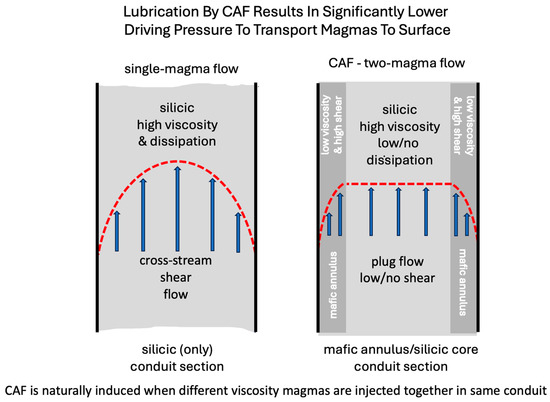
Figure 1.
Comparison between two different modes of transport in a volcanic conduit. Conduit cross-section (left) involves only the flow of a very viscous silicic magma. The existence of a shear-velocity field (red-dashed line) in such a high-viscosity magma produces very high dissipation and the requirement for a larger driving pressure, if magma is to reach the surface. However, two magmas of contrasting viscosity injected into a conduit (right) naturally induce core-annular flow with shear flow limited to the lower-viscosity annular region while the core flow is nearly uniform (“plug” flow). This flow arrangement substantially reduces viscous dissipation resulting in the reduction of the effective driving pressure needed to transport magma to the surface.
1.2. Dike/Conduit Inlet Condition: Simultaneous Injection of Compositionally Distinct Magmas
A requirement for CAF is that magmas with contrasting viscosity are present in the dike or conduit at the same time, which has been observed in the field ([1,2,5,6]). For a magma chamber in which compositional layering has already evolved, Figure 2a illustrates just one possibility for how the eruption of a magmatic dome might occur. In this case, the sloping part of a chamber roof intersects multiple layers while the horizontal part of the ceiling comes into contact with typically only one layer. For fractures propagating along horizontal parts of the chamber boundary, only high withdrawal rates can produce the entrainment of different layers required for simultaneous, two-component flow to occur (Trial et al. [10]). However, for even very small withdrawal rates, both layers can be drawn into a dike or fracture on a sloping boundary that intersects both the silicic and underlying mafic magma layers. Thus, such an intersection gives rise to the possibility of co-injection of the mafic and silicic magmas and the onset of CAF. Figure 2a additionally suggests that injection of highly viscous silicic magma alone into a propagating dike may be unsuccessful in reaching the surface, as a result of its very high viscosity, until it finally intersects a silicic-mafic interface allowing CAF to form and lubricated flow to occur.
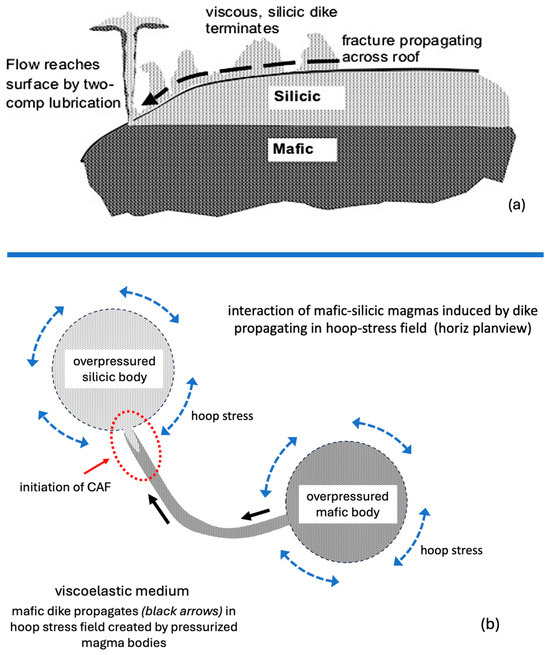
Figure 2.
Two possible ways for magmas, with contrasting viscosities, to be injected into a dike or conduit simultaneously. (a) A dike breaching only the nearly horizontal ceiling of a chamber in which layering has evolved yields only one magma composition during effusive activity. Dike propagation continues until the dike finally intersects a silicic-/mafic-magma-layer interface. This allows multiple layers of magma to be withdrawn simultaneously, initiating core-annular flow. (b) Sketch illustrating an alternative approach to achieving a co-injection boundary condition, which involves the comingling of magmas emanating from two separate magma bodies by means of a dike that is “redirected” from its initial propagation trajectory. The red-dashed oval indicates the region in the dike of mafic-silicic magma interaction. At this location, the potential exists for extending a dike or conduit lubricated by CAF in the vertical (out of the page) direction along the direction of the least principal stress in the vertical plane.
Alternatively, a recent experimental study on dike propagation (Pansino and Taisne [11]) indicates that mafic and silicic magmas, which have evolved separately, may potentially be co-mingled and flow together in the same dike (Figure 2b). The experimental study found that a propagating analog dike is “attracted” by the hoop-stress field created by an over-pressured fluid-filled body embedded in a viscoelastic medium. The authors further found that such dikes breaching a magmatic reservoir do not necessarily cease propagation once they have connected to the over-pressured body, and their analog dike, after contacting the pressurized body, continued to propagate. They concluded that the silicic magma in a reservoir would be equally or more buoyant than the magma in a propagating mafic dike. It could therefore flow inside of the dike and take advantage of the existing fracture to move toward the surface. Such a model for co-mingling two magmas may be more pertinent to the basalt-rhyolite domes mapped in eastern Iceland [1] than a layered magma body with a sloping boundary. Urbani et al. [12] also performed a series of lab experiments that produced an additional understanding of conditions characterizing the viscoelastic medium causing vertical versus horizontal propagation of a dike, which can affect the probability of eruption.
These two possible models for bringing magmas together in a dike or conduit consider the cases where the contrasting magmas have either evolved together in the same chamber or have evolved separately. For this paper, it suffices to conclude that the co-injection of different magmas into a conduit or dike is reasonable, and no preference is given here regarding the origin of contrasting magmas in the discussion that follows.
2. Materials and Methods
Experiment Simulating Two-Component Flow in a Vertical Conduit or Dike
Given a laboratory experiment that is scaled to simulate the geometry of a conduit as well as the flow behavior of different magmas flowing together, it is the degree of dynamic similitude that determines the level of correspondence between flows in the experiment and the magmatic case. For the miscible flows to be dynamically similar, the ratios of the magnitudes of different fluid-dynamic forces must be comparable in both the laboratory and magmatic regimes. One ratio that is particularly important for relating the results of laboratory co-extrusion experiments to two-component magma transport is given by the Reynolds number, Re, which compares the characteristic magnitude of inertial forces in the flow to viscous forces. Very small Reynolds numbers, that is, values that are much less than one, indicate that viscous forces dominate inertial forces as is anticipated for magmatic effusion. Typical estimates of the Reynolds number for polymeric co-extrusion experiments are less than unity. For example, in the set of CAF-extrusion experiments described here approximate values of the flow speed (u), polymer-melt kinematic viscosity (ν) and capillary-tube diameter (d) are 0.02 m/s, 0.01 m2/s and 0.0032 m, respectively. These quantities yield a Reynolds number Re = (ud/ν) of about 0.03 << 1. Other co-extrusion experiments referred to here ([9]) are characterized by comparable Reynolds numbers of about 0.001–0.005. Such values imply dynamical similarity with a 0.003–0.1 m/s flow of rhyolitic magma (ν = 10 m2/s) in a three-meter dike (d)—a most reasonable description for an effusive flow regime. In this range of Reynolds number, the earlier industrially motivated polymer—co-extrusion experiments show that a CAF transition occurs during co-extrusion into cylindrical dies with length-to-diameter ratios of only about 20:1 implying that the CAF regime will be initiated at an early stage during flow along a magma conduit.
Figure 3 illustrates the setup with a dual-syringe, positive displacement pump feeding two separate miscible polymer streams into the bottom end of a high-aspect-ratio (tube length/inner diameter = 130–380:1) vertical tube. The outlet end of the tube penetrates the bottom of a pan acting as a surface onto which the composite polymer flows. The polymer used is Naturosol HHR™, a hydroxyethylcellulose powder that hydrates in dilute (0.5–3%) aqueous solutions to form a highly viscous, shear-thinning (non-Newtonian) liquid. Higher concentrations are very weakly negatively buoyant in lower concentrations of the solution. While shear-thinning behavior has also been identified in magmas, shear-dependent rheology is not a requirement for the CAF transition to occur. For sufficiently low shear rates, higher-concentration solutions of Naturosol exhibit a pseudo-plastic behavior broadly similar to the character of more viscous magmas subjected to low shear stresses. The viscous and shear-thinning behavior of Naturosol solutions has been evaluated by Jones et al. [13]. No attempt has been made to match actual magmatic viscosities or their shear-thinning nature other than to show that a viscosity contrast and non-Newtonian behavior in a scaled conduit geometry can simulate both observed subsurface and surface mafic/silicic zoning. Several experiments were performed in which the effect of viscosity contrast was evaluated using colored, high- and low-viscosity, miscible solutions simultaneously injected into the bottom of the vertical tube and then allowed to flow through the vent and out onto the surface of the pan at the top (Figure 3) simulating a volcanic conduit breaching the surface.
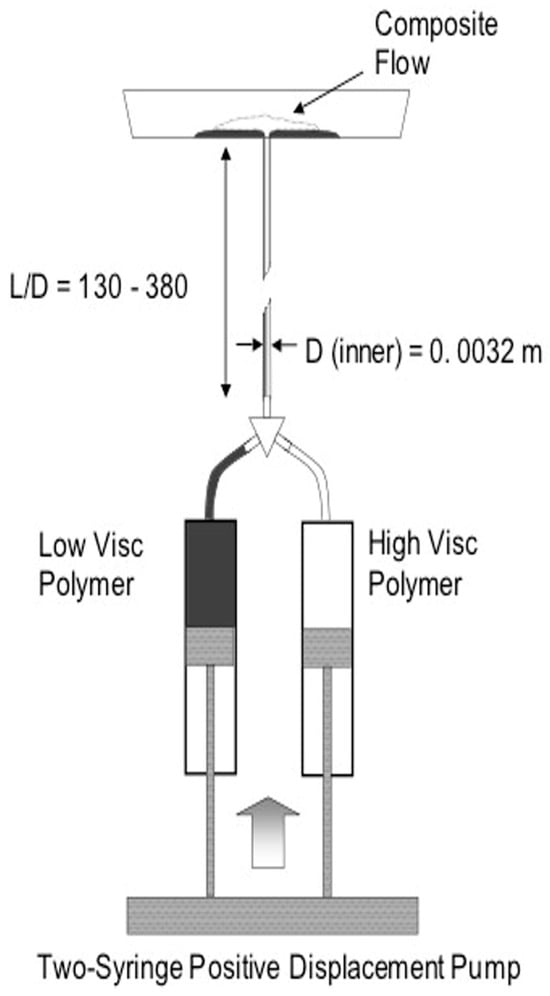
Figure 3.
The apparatus used to simulate the injection of two–component magmas into a conduit. Injection of the Naturosol™ polymers was accomplished with a modified two-syringe, positive displacement pump coupled to the inlet of a vertical Tygon™ tube having a length-to-inner diameter (0.0032 m) of either 130 or 380:1. The flow exits from the vertical tube penetrating the bottom of a pan to simulate the formation of flows on the Earth’s surface.
3. Results
3.1. Co-Extrusion Involving Fluids Having Same Viscosity
To examine the limit of small-to-vanishing viscosity contrast, two miscible, polymeric solutions with the same viscosity were co-extruded side-by-side. Figure 4 shows the flow that was obtained. Because of the equal viscosities, no core-annular flow developed along the length of the tube (130:1). The flow onto the surface shows no evidence of vertical layering of the type characterizing Inyo Domes. Rather, the flow is layered in the horizontal with the polymer solutions flowing away from each other at the vent. In this case, the side of the vent that each stream exits from corresponds to the side of the tube into which each iso-viscous fluid was injected at the bottom. Some mixing of the miscible liquids occurs along the length of the tube as is indicated by the intermediate green zone made up of mixing some of the yellow and blue components. It is important to note that mixing is limited to only a fraction of the polymers vented. (Some mixing may occur on the surface during flow from the vent). When the viscosities are drastically different, the mixing is less even though the liquids remain miscible.
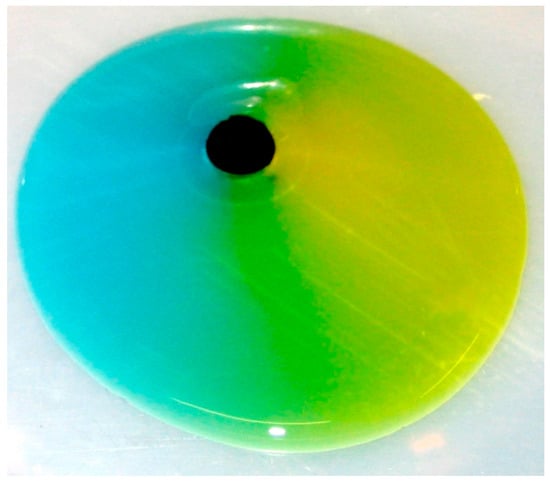
Figure 4.
When two polymer liquids with the same viscosity (0.5% solution) are co-extruded, the low Reynold’s number of streams move up the tube in a side-by-side arrangement. The flow vented at the top varies only on a horizontal plane with the blue and yellow components flowing away from each other. Some minor mixing occurs as indicated by the green regions. (Horizontal scale is 10 cm).
3.2. Co-Extrusion Involving Fluids Having Contrasting Viscosity
Co-extrusion of polymers with an extreme viscosity contrast (0.5% and 3% solutions) produces a somewhat different result. The core-annular flow regime now develops quickly in the vertical tubing of the experiment (380:1 aspect-ratio) with the high-viscosity component (originally yellow but appears green when overlain by blue annular fluid) forming the core of the flow which is encapsulated by the lower viscosity component that forms an annular zone adjacent to the conduit wall (Figure 5a, bottom). A photo-enhanced section of the tubing illustrates more clearly the non-uniform boundary between the annular and core regions of the flow (Figure 5a’). On the surface of the pan, the lower viscosity (blue) component becomes a vehicle to transport the higher viscosity component that is too viscous to flow from the vent alone in the 380:1 geometry (Figure 5a, top). The higher viscosity component is pseudo-plastic producing a broken or “patchy” appearance after ejection from the core of the conduit flow. This sluggish, overlying, non-Newtonian, high-viscosity layer is carried out away from the vent on the surface breaking up into patches when it is stretched too thin by the faster-flowing underlying layer. As it is carried outward to the advancing edge of the flow by the underlying lower-viscosity component, the high-viscosity material is observed to fall before the advancing front with the top layer rolling under the lower layer at the edge of the dome as it moves outward (Figure 5b). This results in a third, base layer that may be a mixture of the other two (Figure 5b). Analyses of drill cores that captured the layering of a dome and its associated conduit in Long Valley, California support the model proposed here (Figure 6). If lower silica content in rock samples implies lower viscosity during the flow of magma in the conduit, then the distribution of silica content measured in the conduit, as shown in the lower plot of Figure 6, would be expected if core-annular flow in the conduit occurred during the eruption of the dome. After venting at the surface, the measured silica distribution in the drill cores taken from the dome indicates that the higher viscosity layer appears to mix with the lower viscosity layer presumably as a result of blocks of breccia being carried over the edge or front of the advancing lower-viscosity flow and then falling beneath it (Figure 6, upper plot).
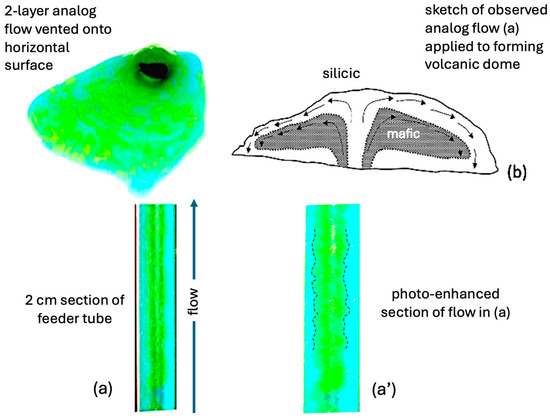
Figure 5.
A strong viscosity contrast (0.5% and 3.0% solutions) results in core annular flow (a, bottom) with the outer light blue flow being much less viscous than the central green core flow in the vertical tube simulating flow a conduit from a photo captured near the midpoint of the tubing. A photo-enhanced section of the vertical tube (a’) shows the distinct CAF regions of high- (green) and low-viscosity (blue) flow. While the boundary between the core and annular region indicated by the dashed lines in (a’) is not smooth, it is quite apparent that CAF exists in this high aspect ratio tube. The resulting surface flow emanating from the vent of the vertical tube on the horizontal platform (Figure 3) is shown in (a, top). This surface flow (horizontal scale is ~6 cm) is vertically layered with the lower-viscosity component underlying the higher. The very high viscosity, very low mobility, patch-like extrudate (non-Newtonian) is carried out away from the vent by the more mobile lower-viscosity component and is observed to roll along the boundaries of the advancing flow. (b) An interpretive sketch of the observed analog flow applied to the dome formation illustrates the effect of the high-viscosity top layer rolling under the lower mafic layer. This can result in producing a bottom layer that is a mixture of the higher- and lower-viscosity material, which appears in the dome-coring data of Figure 6.
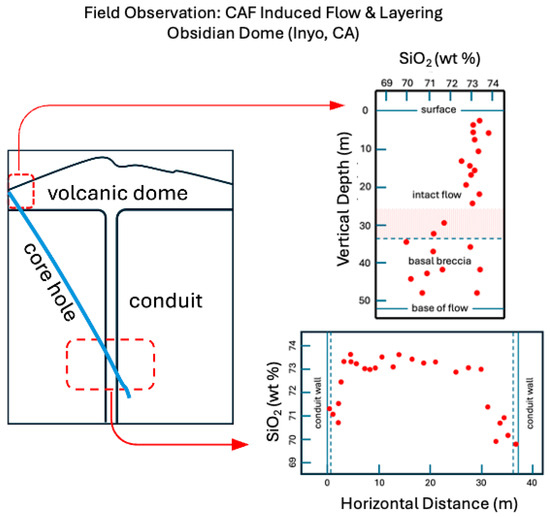
Figure 6.
The distribution of silica content versus location in the feeder conduit and in the overlying dome are illustrated here, where the red-dashed boxes in the conduit/dome graphic indicate the location of the cores used to measure the silica (SiO2) content were obtained. Silica content is plotted (filled red circles) against the transverse or cross-flow location of cores from the conduit. The vertical distribution of silica content (filled red circles) is shown from drill cores taken from the overlying dome. In agreement with the analog experiment, higher silica content rock, correlated with higher viscosity magma, forms the top layer, and the lower silica material occupies the middle layer (red shading). The bottom layer is the basal breccia, composed of lava blocks that avalanched from the passing flow front (Figure 6 adapted from [5,6]).
The effect of self-lubrication by the lower viscosity component is highly apparent. Intermediate viscosity solutions (2% Naturosol™ solutions) are the upper limit for polymers that can be pumped singly by the injection pump used in the experiments described here. In the dual or co-injection mode, lower viscosity polymer (0.5% solution) and very high viscosity polymer (3%) result in a lower drag, core-annular regime that can be driven up the tube much more rapidly than the 2% case by the injection pump motor. The core-annular flow regime can similarly explain how extremely viscous magmas that could not be extruded alone in a limited-pressure magmatic system can reach the surface in the presence of a lower viscosity component.
In our experiment, a moderate viscosity contrast (nominally, 0.5% and 1%) between the co-extruded fluids yields a different doming structure. Rather than the thin, patchy upper layer of very high viscosity non-Newtonian extrudate that is carried away from the vent by the far more mobile extruded lower layer, the upper, more viscous layer builds in volume over the vent as the lower, less viscous layer spreads below it (Figure 7a). However, the upper layer’s moderate viscosity along with its shear-thinning nature allows it also to spread along with the expanding lower layer and even over-run it slightly as a result of the back-pressure of the domed fluid. Regarding the features discussed here, the result (Figure 7a) appears strikingly similar to the volcanic dome (Figure 7b) in the Eastern Iceland Tertiary region mapped by Gibson and Walker [1].
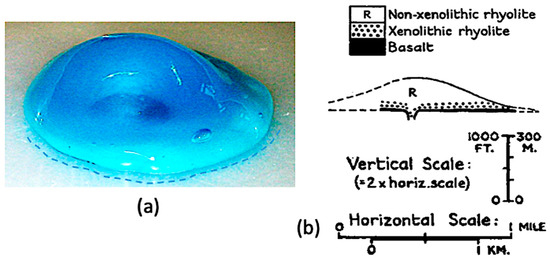
Figure 7.
(a) Co-extrusion involving fluids with moderate viscosity contrast produces a composite domed flow with the domed higher viscosity layer (dark blue) overlying the layer of less viscous fluid (light blue). Both the moderate viscosity contrast and the non-Newtonian shear thinning behavior of the upper layer, which allows dome formation, appear to contribute to the formation of this structure. (Horizontal scale is ~4 cm). (b) A basalt-rhyolite extruded dome (identified as the Köttur flow) exhibiting similar characteristics to (a) including doming and slight overrun by the upper layer was mapped in the eastern Icelandic Tertiary volcanic region by Gibson and Walker [1] (Figure 7b adapted from [1]).
4. Discussion
A dynamical model has now been qualitatively demonstrated spanning the magma transport and dome-formation processes. The results of the experiments clearly show that sequential injections of different magmas are not required to explain vertically zoned lava flows. Gibson and Walker [1] and Carrigan and Eichelberger [5] have both argued that their field observations support a simultaneous two-magma transport process as opposed to sequential injection.
While the occurrence of weak interfacial flow instabilities may produce irregularities of the interface between the annular and core regions, the general CAF structure as shown in Figure 5a,a’ is preserved along the length of the pathway to the surface even in the 380:1 aspect ratio case. Close inspection shows the topography of the interface between the co-extruding polymers resembling the observed interface between mafic and silicic layers (Skelhorn et al. [14]) which can be irregular and may contain enclaves or xenoliths in layered flows. High magmatic viscosities and the relatively small cross-stream length scale (i.e., low Reynolds number) will tend to inhibit large amplitude mixing processes that might effectively destroy the gross normal-zoning features. The stability at the interface between the two magmas may be further enhanced by any local interfacial cooling of the more refractory phase resulting in a “skin” of particularly sluggish magma that will dampen mixing.
What is the effect of cooling on the core-annular regime? Numerical models of cooling fluid with a temperature-dependent viscosity developed using a lattice-gas simulator (Stockman et al. [15]) suggest that cooling of magma at a boundary will cause the magma to gradually become more viscous downstream. This leads to instability within the lubricating layer itself that causes an exchange within the same layer between the cooler and more viscous, “wall” magma and the hotter, lower viscosity “interior” magma of the annular zone. This exchange appears analogous to the mechanism responsible for the formation of core-annular flow involving compositionally distinct magmas except that here we are dealing with cooler and warmer regions of the same magma. Calculations suggest that such an intra-layer exchange instability need only provide a very small transverse component to offset boundary cooling (Carrigan et al. [16]).
Regarding composite flows, our new laboratory observations qualitatively demonstrate that viscosity contrast has an important influence on the nature of layering in volcanic flows. Additionally, the non-Newtonian, shear thinning nature of the polymer solutions in conjunction with viscosity differences also produce secondary doming features (e.g., dome shape, higher viscosity upper layer over-running edge of lower viscosity bottom layer) in agreement with the observations. This gross layering structure (Figure 5), including the underflow of the bottom layer by the top layer (Figure 5b), is borne out by the drilling studies of Obsidian Dome (Figure 6). Of course, even finer details of the flow structure are less easily modeled by the experiments described here. While the Naturosol™ polymer solutions exhibit non-Newtonian, shear-thinning behavior, they cannot exactly replicate the rheological behavior of lavas including the crystallization in the more viscous lavas owing to loss of volatiles during transport.
Lubrication of a viscous magma flowing in a propagating dike by a less viscous magma may also play a significant role in triggering volcanic eruptions. Observations of energetic eruptions involving two compositionally distinct magmas with significantly different inferred viscosities are common although there is no general model for how the bimodal composition produces an eruption (e.g., Pallister et al. [17], Takeuchi and Nakamura [18], Leonard et al. [19], Devine et al. [20]). However, it is generally accepted that viscous losses resulting from magma flow in narrow fractures are far more important than rock-fracture toughness in estimating whether the level of pressurization in a magma chamber is adequate to propagate a dike large distances (Spence and Turcotte [21], Lister and Kerr [22]). With an approximate analytical model, it has already been shown that basalt-lubricated rhyolite can propagate more than 100 times the rate of rhyolite alone for the same magma-chamber-pressure history (Carrigan [6]). While the mafic magma may provide the necessary lubrication for the co-extrusive flow, it may in certain scenarios not contain adequate volatiles for exsolution to reduce the bulk magma density ρdike to the level required to enhance the ascent rate of magma in the dike by forming a foam. (The excess inlet pressure available to drive magma upward within a dike is equal to the magma-chamber pressure pmag, at the inlet, less the pressure associated with the weight of the vertical column of length, l, of magma in the dike subject to gravity, g, that is, pmag − ρdikegl). However, the silicic component can potentially have a higher volatile content that exsolves during the decompression associated with sufficiently rapid transport upward in a dike or conduit (Eichelberger et al. [23], Jaupart and Allegre [24], Mangan et al. [25]). This results in a reduced bulk density ρdike and a correspondingly greater driving pressure, pmag − ρdikegl. Again, this is only possible because the wetter silicic magma is enabled, by the lubrication provided by the mafic component, to rise sufficiently fast in the dike (reducing gas loss) to a lower pressure regime where it acquires a lower density owing to exsolution.
Finally, the co-extrusion model for magmas originally proposed by Carrigan and Eichelberger [5] to explain the layering of Obsidian Dome has been criticized on grounds relating to the miscibility of co-extruded magmas and the small Reynolds number associated with effusive transport. Such criticisms (e.g., Koyaguchi and Takada [26]) result from a general misunderstanding of both the CAF transition as well as the less significant dynamical role of miscibility in low Reynolds number, two-component flows. Koyaguchi and Takada have assumed that the CAF transition applies only to larger Reynolds number, immiscible cases such as that characterizing water-oil transport in pipelines (Joseph et al. [27], Preziosi et al. [28]) while overlooking the more dynamically relevant body of research on the successful CAF transition of miscible polymers at low Reynolds number (Han [9], Minigawa and White [29]). The low-Reynolds number, miscible flows described here are the most realistic laboratory evaluations of the magmatic co-extrusive model of dome formation to date. They clearly show the roles of the transition to CAF in a low Reynolds number, miscible flow regime along with the effects of viscosity contrast and shear-thinning rheology on the production of compositionally layered volcanic flows.
5. Conclusions
The main purpose of this study was to identify conditions relevant to magma transport, eruption and the formation of volcanic domes in the context of CAF. To our knowledge, this is the first laboratory effort specifically intended to simulate aspects of magmatic co-extrusion by employing realistic geometry, boundary conditions, flow conditions and differing rheologies of the liquids used in the study. The inlet boundary condition of this experiment simulates what might occur when a dike or conduit is fed by either a layered reservoir containing magmas of contrasting viscosity or two reservoirs containing different magmas (Figure 2a,b). These magma scenarios seem reasonable and permit an injection boundary condition resulting in co-extrusion and CAF. We find that CAF develops rapidly after co-injection of the liquids into the high-aspect-ratio tubing at low Reynolds numbers relevant to magma transport. The layering observed in the tubing is analogous to what has been documented in the field ([1,5]). In addition, layered extrudate vented on the platform of the experiment resembles different observed doming features depending on the degrees of viscosity contrast and shear-thinning (non-Newtonian) behavior. The results presented here would seem to offer a realistic basis for developing improved dynamical models of magma transport and eruption that include the multiple effects of ascent rate, which Gonnermann and Manga [30], Papale [31], Sparks [32], Wilson et al. [33] and others have argued control the nature of an eruption. While we have focused attention on the case of two distinct magmas having different silica contents, it is important to point out that magmas are inherently complex materials that may contain non-uniform distributions of crystals, bubbles and volatiles that affect viscosity. Shear flow associated with the near-wall regions of a dike or conduit can induce redistribution of magmas as well as the crystals and bubbles in the magma. Future laboratory and theoretical studies might consider the effects of viscous heating, melt-crystal and bubble segregation during flow as well as heat loss from the annular zone on the ability of this lubricating layer to reduce pressure losses during the magma co-extrusion process.
Author Contributions
Conceptualization, C.R.C. and J.C.E.; methodology, C.R.C.; investigation, C.R.C.; data curation, C.R.C.; writing—original draft preparation, C.R.C.; writing—review and editing, C.R.C. and J.C.E.; funding acquisition, C.R.C. and J.C.E. All authors have read and agreed to the published version of the manuscript.
Funding
C.R. Carrigan gratefully acknowledges the LLNL Professional Research & Teaching Leave Program (2002–2003) and the US-UK Fulbright Commission for support of this work. The LLNL contribution is under the auspices of the U.S. Department of Energy, contract number W-7405-ENG-48. Both C.R. Carrigan and J.C. Eichelberger acknowledge support of Inyo Domes drilling by Basic Energy Sciences, U.S. Department of Energy via Sandia National Laboratories (contract number no longer available) and current support of his time by Alaska Division of Geological and Geophysical Surveys.
Data Availability Statement
The original contributions presented in this study are included in the article. Further inquiries can be directed to the corresponding author.
Acknowledgments
C.R.C. expresses his appreciation for the support and contributions of R.S. White, Andrew Pluck and Thierry Menand of the University of Cambridge and University of Clermont Auvergne. C.R.C. also thanks the leadership and staff of St. Edmund’s College, Cambridge for their support while he was a visiting fellow.
Conflicts of Interest
The authors declare no conflicts of interest.
Abbreviations
The following abbreviations are used in this manuscript:
| CAF | Core Annular Flow |
| Re | Reynolds number: ud/ν (dimensionless) |
| d | Inner diameter of co-extrusion tube or magma conduit (m) |
| g | Gravitational acceleration (m/s2) |
| l | Length of co-extrusion tube or magma conduit (m) |
| pmag | Pressure in source magma chamber (kg/m·s2) |
| ρdike | Bulk density in conduit column (kg/m3) |
| u | Characteristic flow speed in co-extrusion tube or magma conduit (m/s) |
| ν | Characteristic kinematic viscosity (m2/s) |
References
- Gibson, I.L.; Walker, G.P.L. Some composite rhyolite/basalt lavas and related composite dykes in eastern Iceland. Proc. Geol. Assoc. 1964, 74, 301–318. [Google Scholar] [CrossRef]
- Walker, G.P.L.; Skelhorn, R.R. Some associations of acid and basic igneous rocks. Earth-Sci. Rev. 1966, 2, 93–109. [Google Scholar] [CrossRef]
- Blake, S.; Campbell, I.H. The dynamics of magma-mixing during flow in volcanic conduits. Contrib. Mineral. Petrol. 1986, 94, 72–81. [Google Scholar] [CrossRef]
- Vogel, T.A.; Eichelberger, J.C.; Younker, L.W.; Schuraytz, B.C.; Horowitz, J.P.; Stockman, H.W.; Westrich, H.R. Petrology and emplacement dynamics of intrusive and extrusive rhyolites of Obsidian Dome, Inyo Craters volcanic chain, eastern California. J. Geophys. Res. 1989, 94, 17937–17956. [Google Scholar] [CrossRef]
- Carrigan, C.R.; Eichelberger, J.C. Zoning of magmas by viscosity in volcanic conduits. Nature 1990, 343, 248–251. [Google Scholar] [CrossRef]
- Carrigan, C.R. Two-component magma transport and the origin of composite intrusions and lava flows. In Magmatic Systems, 1st ed.; Ryan, M.P., Ed.; Academic Press: New York, NY, USA, 1994; pp. 319–354. [Google Scholar] [CrossRef]
- Kavanagh, J.L.; Engwell, S.L.; Martin, S.A. A review of laboratory and numerical modelling in volcanology. Solid Earth 2018, 9, 531–571. [Google Scholar] [CrossRef]
- Poppe, S.; Gilchrist, J.T.; Breard, E.C.P.; Graettinger, A.; Pansino, S. Analog experiments in volcanology: Towards multimethod, upscaled, and integrated models. Bull. Volcanol. 2022, 84, 52. [Google Scholar] [CrossRef]
- Han, C.D. A study of co-extrusion in a circular die. J. Appl. Polym. Sci. 1975, 19, 1875–1883. [Google Scholar] [CrossRef]
- Trial, A.F.; Spera, F.J.; Greer, J.; Yuen, D. Simulations of magma withdrawal from compositionally zoned bodies. J. Geophys. Res. 1992, 97, 6713–6733. [Google Scholar] [CrossRef]
- Pansino, S.; Taisne, B. How magmatic storage regions attract and repel propagating dikes. J. Geophys. Res. 2018, 124, 274–290. [Google Scholar] [CrossRef]
- Urbani, S.; Acocella, V.; Rivalta, E. What drives the lateral versus vertical propagation of dikes? Insights from analogue models. J. Geophys. Res. Solid Earth 2018, 123, 3680–3697. [Google Scholar] [CrossRef]
- Jones, T.J.; Lewellin, E.W.; Mader, H.M. The use of a shear-thinning polymer as a bubbly magma analogue for scaled laboratory experiments. J. Volcanol. Geotherm. Res. 2020, 392, 106768. [Google Scholar] [CrossRef]
- Skelhorn, R.R.; MacDougall, J.D.S.; Longland, P.J.N. The Tertiary igneous geology of the Isle of Mull. In Geologists’ Association Guides; No. 20; Benham and Co., Ltd.: London, UK, 1969; 35p. [Google Scholar]
- Stockman, H.W.; Stockman, C.T.; Carrigan, C.R. Modelling viscous segregation in immiscible fluids using lattice-gas automata. Nature 1990, 348, 523–525. [Google Scholar] [CrossRef]
- Carrigan, C.R.; Schubert, G.; Eichelberger, J.C. Thermal and dynamical regimes of single- and two-phase magmatic flow in dikes. J. Geophys. Res. 1992, 97, 17377–17392. [Google Scholar] [CrossRef]
- Pallister, J.S.; Hoblitt, R.P.; Reyes, A.G. A basalt trigger for the 1991 eruptions of Pinatubo volcano. Nature 1992, 356, 426–428. [Google Scholar] [CrossRef]
- Takeuchi, S.; Nakamura, M. Role of precursory less-viscous mixed magma in the eruption of phenocryst-rich magma: Evidence from the Hokkaido-Komagatake 1929 eruption. Bull. Volcanol. 2001, 63, 365–376. [Google Scholar] [CrossRef]
- Leonard, G.S.; Cole, J.S.; Nairn, I.A.; Self, S. Basalt triggering of the c. AD 1305 Kaharoa rhyolite eruption, Tarawera Volcanic Complex, New Zealand. J. Volcanol. Geotherm. Res. 2002, 115, 461–486. [Google Scholar] [CrossRef]
- Devine, J.D.; Rutherford, M.J.; Norton, G.E.; Young, S.R. Magma storage region processes inferred from geochemistry of Fe-Ti oxides in andesitic magma, Soufriere Hills Volcano, Montserrat, WI. J. Petrol. 2003, 44, 1375–1400. [Google Scholar] [CrossRef]
- Spence, D.A.; Turcotte, D.L. Magma-driven propagation of cracks. J. Geophys. Res. 1985, 90, 575–580. [Google Scholar] [CrossRef]
- Lister, J.R.; Kerr, R.C. Fluid-mechanical models of crack propagation and their application to magma transport in dykes. J. Geophys. Res. 1991, 96, 10049–10077. [Google Scholar] [CrossRef]
- Eichelberger, J.C.; Carrigan, C.R.; Westrich, H.R.; Price, R.H. Nonexplosive silicic volcanism. Nature 1986, 323, 598–602. [Google Scholar] [CrossRef]
- Jaupart, C.; Allegre, C.J. Gas content, eruption rate and instabilities of eruption regime in silicic volcanoes. Earth Planet. Sci. Lett. 1991, 102, 413–429. [Google Scholar] [CrossRef]
- Mangan, M.; Mastin, L.; Sisson, T. Gas evolution in eruptive conduits: Combining insights from high temperature and pressure decompression experiments with steady-state flow modeling. J. Volcanol. Geotherm. Res. 2004, 129, 23–36. [Google Scholar] [CrossRef]
- Koyaguchi, T.; Takada, A. An experimental study on the formation of composite intrusions from zoned magma chambers. J. Volcanol. Geotherm. Res. 1994, 59, 261–267. [Google Scholar] [CrossRef]
- Joseph, D.D.; Renardy, Y.; Renardy, M. Instability of the flow of two immiscible liquids with different viscosities in a pipe. J. Fluid Mech. 1984, 141, 309–317. [Google Scholar] [CrossRef]
- Preziosi, L.; Chen, K.; Joseph, D.D. Lubricated pipelining: Stability of core-annular flow. J. Fluid Mech. 1989, 201, 323–356. [Google Scholar] [CrossRef]
- Minagawa, N.; White, J.L. Co-extrusion of unfilled and TiO2-filled Polyethylene: Influence of viscosity and die cross-section on interface shape. Polym. Eng. Sci. 1975, 15, 825–830. [Google Scholar] [CrossRef]
- Gonnermann, H.M.; Manga, M. The fluid mechanics inside a volcano. Annu. Rev. Fluid Mech. 2007, 39, 321–356. [Google Scholar] [CrossRef]
- Papale, P. Strain-induced magma fragmentation in explosive eruptions. Nature 1999, 397, 425–428. [Google Scholar] [CrossRef]
- Sparks, R.S.J. Forecasting volcanic eruptions. Earth Planet. Sci. Lett. 2003, 210, 1–15. [Google Scholar] [CrossRef]
- Wilson, L.; Sparks, R.S.J.; Walker, G.P.L. Explosive volcanic eruptions—IV. The control of magma properties and conduit geometry on eruption column behaviour. Geophys. J. Int. 1980, 63, 117–148. [Google Scholar] [CrossRef]
Disclaimer/Publisher’s Note: The statements, opinions and data contained in all publications are solely those of the individual author(s) and contributor(s) and not of MDPI and/or the editor(s). MDPI and/or the editor(s) disclaim responsibility for any injury to people or property resulting from any ideas, methods, instructions or products referred to in the content. |
© 2025 by the authors. Licensee MDPI, Basel, Switzerland. This article is an open access article distributed under the terms and conditions of the Creative Commons Attribution (CC BY) license (https://creativecommons.org/licenses/by/4.0/).